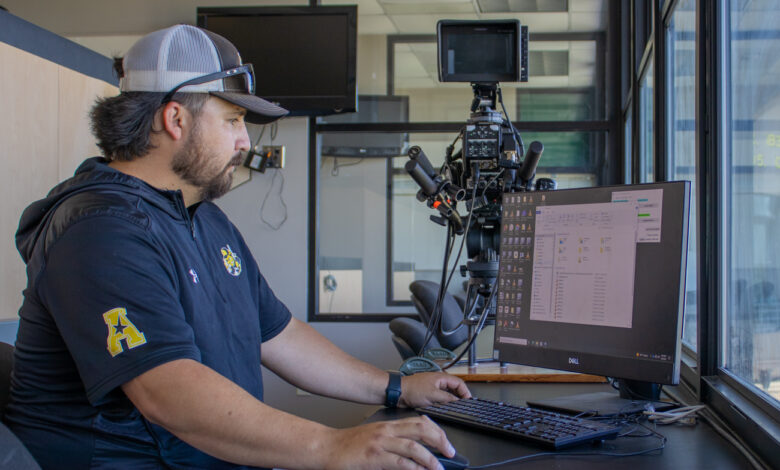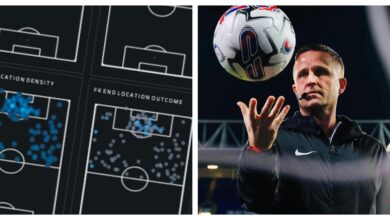How Wichita State baseball uses data and analytics for player development – The Sunflower

Emilio Escamilla, the director of video and data analytics for Wichita State baseball, has a phrase he consistently repeats when describing the value of his job: “adapt or die.”
The quote, originating from the 2011 sports movie “Moneyball,” reflects the constantly-changing analytical strategies baseball programs must employ to gain advantages in a competitive sport where minor changes make a big difference.
“We just kind of want to stay ahead of the curve or on the curve, not behind it so that we can make sure that we are basically producing better players or maximizing the player’s performance,” Escamilla said.
At the center of recent innovations in the baseball world is ball and tracking technology.
Escamilla described Wichita State’s system, the TrackMan, as “a very advanced radar gun” that can measure, on top of basic velocity, how much a ball spins in the air and what axis it spins on, how it moves, how high in the air it was released and much more.
The Shockers have used the technology for a few seasons, but Escamilla said this is the first year the team acquired a portable version that could be used in the bullpens and practice sessions.
Mixing data and tradition
Escamilla was an intern for the analytics department last year and stepped into the director role this season when new baseball head coach Brian Green was hired. Escamilla is working on a master’s in mathematics and views analytics as a mesh of two of his passions.
“Baseball has been really my life, as long as I can remember,” Escamilla said. “So, I kind of wanted to get into this and really didn’t know how until I got the opportunity.”
Escamilla passes on information from the TrackMan to the coaching staff, who use “a good mix” of data and traditional perspectives to teach and improve the players. He said acceptance of analytics has increased over time “because it works.”
“The analytics is … for the coaching staff to facilitate the players’ development so that we can act on things that we might miss with the naked eye,” Escamilla said
Wichita State pitching coach Anthony Claggett has worked with Green at New Mexico State University, Washington State University and now with the Shockers. He said when the analytics were first introduced to him when he was at New Mexico State, he slowly adjusted to understanding and using it more in his coaching.
Claggett said how much he decides to use analytics in his coaching depends on the player. For players who commit to an analytic approach, the TrackMan system can measure the movement they get on their pitches, which can allow them to experiment with tweaks that can make a big difference.
“The player has to buy in; the player has to be able to understand what you’re trying to achieve by making those adjustments,” Claggett said. “So there’s a lot that goes into that from a pitching standpoint … slight adjustments sometimes can change the pitchers’ arsenal and make them a better pitcher.”
One player who has bought into the analytics is sophomore right-handed pitcher Caleb Anderson, who called the TrackMan “absolutely essential” for his pitching development. Anderson often adjusts his throwing mechanics based on the TrackMan feedback.
“For me personally, it’s like a second pair of eyes that are way smarter than mine,” Anderson said. “So it’s almost like a pitching genius to watch you pitch and give you instant feedback that you wouldn’t get if you didn’t have anything there.”
Anderson usually makes major adjustments in the fall when there’s more ability to experiment. He credited Escamilla for providing data and Claggett for helping translate some of the information into results.
“I think it’s made a drastic improvement in my development,” Anderson said. “I’m not a super math guy, but the metrics and analytics are really good when you kind of don’t know where else to look.”
Staying ahead of the curve
Escamilla said that every team in the American Athletic Conference has a TrackMan, but called Wichita State “the cream of the crop” when it comes to usage of analytics.
Escamilla runs a single-person analytics department, a decrease in manpower from previous years. He said he is looking for more interns to expand the number of projects he can complete for the team.
Next year, the team plans to add a performance lab that will incorporate the TrackMan with even more advanced biometric data that could be used to analyze player mechanics and movements. Claggett could not contain his excitement when talking about what the lab could do for player development.
“It will be state of the art,” Claggett said. “It will be an incredible working space … So the data, the metrics, the technology, we’ll have it all.”
Claggett reiterated the importance of continuing to advance how the team uses data.
“It’s a never-ending cycle of what’s going to be new,” Claggett said. “I mean, five years from now, there’s going to be a lot different information … And so the trend will always kind of change.”



